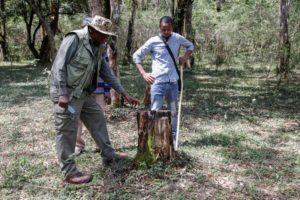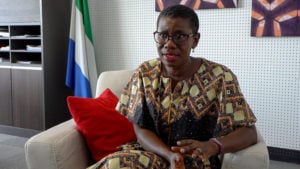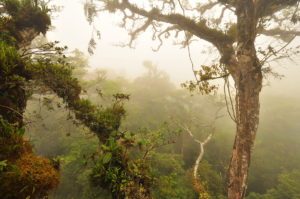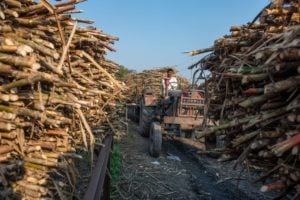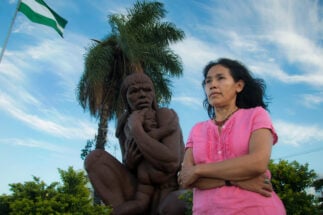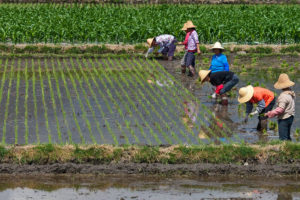On the outskirts of Kenya’s capital, Nairobi, 70-year-old Lucy Wanja is watering silver oak seedlings in a nursery in the Oloolua Forest.
Editor’s note
Watch out for the audio version of this article, coming soon.
Wanja and over 30 other elderly women from nearby villages have been working together as volunteers to replant indigenous trees in the forest for 13 years now. They spend three to four days a week sourcing and watering seedlings, as well as caring for the young trees once planted out.
As Wanja explains, the women have strong motivations driving them: “We found this area densely forested. But the indigenous trees were cut down, and quarries extracting soil left gaping holes in the forest. We are here because we want our children to breathe fresh air like we did before, and to protect our soil from erosion. Before we came together as women from the neighbouring villages, our children would be robbed and beaten by thugs hiding in the quarries while on their way to school or work. Some were killed, and some young people would come here to commit suicide. The quarries were also used by people taking drugs. So, we agreed as women to do something to make this a safer place. Replanting the trees was our way of covering the holes left by the quarries in the hope that one day the forest can return to the way it was before.”
A fragmented tropical dry forest, Oloolua is part of the larger Ngong forest ecosystem, which also includes the forests of the Ngong Hills and the Kibiko-Empakasi Forest.
It is one of the few remaining urban forests in the Kenyan capital, but has suffered from decades of degradation. Then three years ago, a large number of indigenous trees were cut for improvements to the road linking Embulbul and Gataka, and for phase two of the standard gauge railway, the SGR – an ambitious China-backed project that aims to connect Kenya’s coastal city of Mombasa with the landlocked countries of Uganda and Rwanda.
Kenya needs this kind of development, but how can the country make sure it doesn’t negatively impact on communities and their right to a clean and healthy environment, something that’s protected in the constitution? Against the backdrop of climate change, how can progress be achieved in a way that also protects the vital life support system nature provides? And how can it be ensured that development benefits everyone, including women like Wanja?
These are the questions we will be exploring in this two-part series on just transitions, brought to you by Africa Climate Conversations in collaboration with China Dialogue.
Decades of degradation
As chair of the Oloolua Community Forest Association, environmentalist Christopher Muriithi knows the history of the area well. He explains how population growth and urban expansion in the early 1990s led to something of a free-for-all in the forest.
“People needed resources, they needed wood, they needed timber for building structures and those kinds of stuff. The only place they could acquire them for free was inside the forest. And so, a lot of cutting of trees went ahead. [In] pristine areas, indigenous trees were felled down – hardwoods like Olea africana [and] silver oak.”
Once the trees were felled, areas of the forest were also quarried for construction materials. Muriithi says the combination had a significant impact on the local environment.
“By early 2000, the situation had worsened. People started seeing [that it was] becoming warmer, and the forest was becoming more fragmented. We used to see giraffes, we used to see buffaloes. They were not there any more. The farms around the entire Oloolua Forest started changing. The crops they used to grow are no longer there. The land started becoming more barren, more dry. The rivers and streams that cut through the forest started being polluted. The ecosystem was disturbed, and it couldn’t sustain the life that was in it.”
As a result, in 2002, Muriithi says the local community went to the court and lobbied to stop the forest from being destroyed further. Their campaign was successful, and they went on to form environmental groups to start thinking of ways to rehabilitate the forest.
This was how Wanja and her group of local women started replanting Oloolua’s trees, despite their limited resources.
“We’ve never earned a penny in the forest. We have always dug into our pockets to buy the seedlings, and water them during drought. But this year, we see that God has noticed our efforts. There are more areas in Kenya where trees are being replanted. So, we are selling between 100–400 seedlings.”
Wanja explains that the profits from these sales are shared equally between the members of her group. This means they each get less than a dollar a month, at least when it rains. At other times, their earnings have to be spent on water for the seedlings.
But Wanja is happy. She sees the positive impact her work is having: “The air is great, and it’s satisfying being here. We are older women past fetching water with huge jerricans, but we do it gladly. We go back home happy because we have had time to gather, pray, breathe fresh air and work together. We also get visitors at the end of the day. It’s good for the heart.”
A railway cuts through it
One of the things that makes the Ngong Forest ecosystem so important is its numerous rivers and springs. Gideon Tipaya of the Ngong Hills Mbagathi Water Resource Users Association explains that many of these waterways meet in the Oloolua Forest. “Then all these rivers, including the Mbagathi River, go all the way to the Athi River. They feed the Athi. And from the Athi, [which becomes the] Sabaki River, [they go] down to the Indian Ocean.”
As Muriithi said, the damage inflicted on the Oloolua Forest made the area drier, impacting on local farmers. Without the trees to gather and release moisture into the atmosphere, less rain has been falling. But Tipaya points out it’s not just about the forest microclimate.
“Over the years, there’s been a lot of human activity that has made a big impact on our rivers [and] springs. There’s been issues with climate change, which is a crisis that we are all experiencing. It’s here with us. It’s a reality. And we’ve seen a reduction of rainfall. Actually, we’ve [been] experiencing very long droughts for the last couple of years, and that is affecting the water tables, because now there’s no recharge to the springs.”
Given all of these issues, the last thing Oloolua needed was a major infrastructure project.
Phase two of the SGR project aims to link Nairobi with Malaba on the Kenya–Uganda border. It is an extension of the line from Mombasa to the Kenyan capital completed in 2017. The first part of this extension, opened in 2019, goes to the town of Naivasha. It was built by the China Communications Construction Company, and 85% of the cost for this section was funded by a loan from the Export-Import Bank of China worth US$1.5 billion. The remaining 15% was provided by the government of Kenya via the Railway Development Levy Fund.
When Muriithi and the communities of Oloolua heard that the SGR would be cutting through the forest, they did their best to stop it.
“I can remember those days in 2014, 2015, we lobbied a lot. We said: ‘The forest has taken a lot of beating and a lot of destruction. Is there no other way? Can that SGR pass through somewhere else?’”
Muriithi understands that development has to come, but laments that “it comes with a big cost”.
This is a tree that sinks in the carbon dioxide that I breathe out. So we are integrated.Christopher Muriithi, chair of the Oloolua Community Forest Association
“We fought hard to raise our concerns and to find ways [that] the project could be taken elsewhere. But the government had its way. And the SGR line crossed over the Nairobi National Park into Oloolua Forest, where it cut nearly 13 hectares of pristine forest. That’s a very, very big chunk of indigenous forest.”
As soon as it leaves forest, the SGR enters a 4.5km tunnel drilled through the hills that cradle the Ngong Forest ecosystem. Tipaya explains how the construction of this tunnel interfered with the groundwater feeding the area’s many springs.
“The SGR has come with its fair share of blessings in terms of communication and transport. But on the same level, when they were drilling the tunnel, they interfered with the water table, the aquifer, and the water was redirected to Kajiado West. So that has made some of the rivers on this other side to actually diminish in water levels.”
Tipaya says the movement of trucks during the construction of the railway also had an impact.
“The railway line was actually constructed right next to a stream. So you can imagine the kind of degradation that happened in the catchment area, given that the lorries made the soil loose and with time when it rained, the soil [was washed] down to the stream. And this brought about sedimentation. So there was a reduction of water levels due to sedimentation.”
All this has made access to water difficult for many people living in the Oloolua area. Bernadetta Wanjiru, a 74-year-old mother of five from Embulbul village, says the water in the streams and rivers used to be plentiful and safe to drink. But today, like many residents in her village, she has no choice but to buy salty borehole water for drinking and household use.
“In my neighbourhood, there is a mosque and water kiosks provided by the government and run by community women’s groups. At the water kiosk, we can buy a 20-litre jerrican for two shillings [about US$0.02], and the same sells for three shillings at the mosque. The mosque’s borehole is salty. The kiosk water is sweet. But the kiosk water is problematic because the taps can go dry for two to three months. So mostly we are forced to use the salty water, as it is at least available.”
‘Trees support our lives’
Despite the damage these sections of the SGR have caused, its overall purpose is positive. As part of a wider network of railways that will strengthen economic links across East Africa, it is key to Kenya’s “Vision 2030” development programme. This aims to transform Kenya into a “middle-income country providing a high quality of life to all its citizens” by the end of this decade.
However, to achieve this, Muriithi warns that the environmental and social impacts of big projects like the SGR must be taken into account.
“These companies that are working here in Kenya, they also work elsewhere, like in China. And when I look at the way they are doing their construction in their own countries, it’s not the way they are doing it in our countries. You’d find in many places, if there was a forested area, either the road would be pitched high up or it would be underground. And if the impact to the environment was more severe compared to the benefits that the development would bring, then the whole development would be discarded. There could be other alternatives of transportation. We don’t have to have roads in the forest.”
For Muriithi, destructive projects are still being allowed to go ahead in Kenya because “we lack that value of seeing our environment as important as my own life. If someone kills or hurts someone, for sure you’ll be taken to court. You’ll either be jailed or you’ll be fined. So it’s a crime. But when people cut trees, it’s not a crime. It should be a crime. This is a tree that sinks in the carbon dioxide that I breathe out. So we are integrated. Trees support our lives. But we are destroying vast lands because we see no value. No value in that forest, no value in that tree.”
The laws are there
Along with many other countries in Africa, Kenya does already have good policies in place to protect the environment. These policies are based on rights enshrined in the Kenya’s constitution, explains Robert Kibugi, an expert in environmental law at the University of Nairobi.
“The right to a clean and healthy environment has been recognised in Kenya since the early 2000s. Initially this was on account of the Environmental Management and Coordination Act, which brought around the idea that there is a human right to a clean and healthy environment. But it gained constitutional status through a court decision around 2005, when a court said that the right to a clean and healthy environment was extensive from the right to life. You really couldn’t enjoy your right to life unless you had a clean and healthy environment. And so, when Kenya got a new constitution in 2010, this was included in Article 42. It is protected in a variety of ways. One of them is the right to go to court.”
Kibugi goes on to explain that the constitution also includes a series of obligations on the Kenyan state designed to realise the human right to a clean and healthy environment. These includes things like “increasing tree cover in the country to up to 10% of the total land area, the establishment of environmental impact assessments and audits, the elimination of harmful environmental practices, the protection of indigenous knowledge, encouraging public participation and so on.”
If the government of Kenya fails to meet these obligations, then people can use their constitutional right to go to court, he says.
However, although the laws are there, and Kibugi says Kenya has done well in framing them, he warns that implementation is wanting.
“The right to a clean and healthy environment is a common casualty to prioritisation of economic growth and economic priorities. Because you might realise that a lot of the economic outputs set out in development plans are potentially drivers of environmental degradation, and these are what are largely prioritised.”
In addition, Kibugi warns that Kenya faces increasing challenges around “political interference, disregard [and] failure to enforce conditions”.
Given these challenges, he argues that civil society plays a key role in ensuring laws are implemented and the government meets its obligations. And he says there are tools in place that ordinary people can use to take action when their right to a clean and healthy environment is being infringed upon.
He gives the example of a “controlled environmental audit”, which can be carried out by the Environment Authority if people who are impacted by an economic activity complain that there is non-compliance.
However, as Kibugi points out, the issue with this, both in Kenya and elsewhere, is that “the people affected may not always know the procedures that you need to follow, and may also not necessarily elicit the interest of the public officials that are concerned.
“This is where the role of organising in the form of protest, whether it’s online or in person, to draw attention to some of these things, would happen. And I would say that eventually court action is necessary. But I always say it is [only] necessary as a last resort.”
Why must the people fight?
Kenya’s system of enforcing environmental laws, as described by Kibugi, places a huge burden on the general public to act as rights defenders. There are those, like Muriithi, who are happy and able to take on this difficult role. But even he often feels he’s fighting a losing battle.
“Every time you raise a voice, that’s politics. People want you to see wrong, but they don’t want you to speak about those wrongs. As a community, we are seen as anti-development, [that] we don’t want development.”
Muriithi sees it as a great injustice, “when we have all these good laws [in place], and yet we, the community, have to struggle to make sense [of them]. It’s like we [have] to force things to happen, yet we have laws that should be enforced so that these things are done correctly.”
The last resort of the courts is too expensive and difficult for most ordinary people. And, as Kibugi says, victory is far from guaranteed.
“If you go to court but don’t secure an injunction, then the polluting activity will continue. And in any case, as we have seen recently in a case involving lead battery acid pollution, the High Court, which is the Constitutional Court, gave the appropriate orders in favour of the affected community. But then the public agencies have gone to the Court of Appeal, and that may take about a year. And it’s very likely the matter will end up in the Supreme Court, which could take another year or two before justice has been rendered. In that case, if the public agencies concerned had actually done their work when called upon to do it by the public, everybody would have been saved a lot of pain.”
Surviving the climate crisis
Over the last four years, below-average rainfall in the Horn of Africa has created one of the worst climate-related emergencies of the past 40 years. UNICEF reports that by early October 2022, 8.5 million people were facing severe water shortages, and 20 million required immediate food assistance.
Now more than ever, African nations need to protect their environments, both to counter climate change, and to ensure communities are as resilient as they can be to deal with the challenges they’re already facing. Development needs to play a part in this. How exactly, will be explored in more depth in part two of this series.
Back in Oloolua Forest, Lucy Wanja knows what needs to happen if communities like hers are to survive.
“The government should prioritise forests like these, even if it calls for fencing to make sure no one will ever come dumping in the forest. But laws must be enforced too. Because traditionally, forests were important and protected to the extent that there were notices on which the laws would be displayed. Plucking a toothbrush-size twig was enough to get you arrested as it was against the law. But today, forests are being left bare and illegal loggers are free to harvest haphazardly for business.”
While she waits for the government to enforce their own laws, Wanja is content staying under the radar, quietly doing her little bit to make this patch of Africa a better place.
“We never asked for government permission to do this. Some have questioned who gave us permission. Are we supposed to help the government, or should it serve us? But none of this scares us. We replant the trees. It’s like a covenant we made with God to make things right.”
